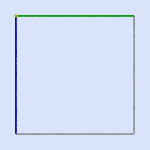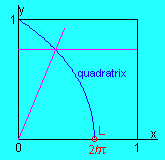 |
 |
THE QUADRATRIX
Trisecting an angle - Squaring the circle
Introduction
Three famous geometrical construction problems, originating from ancient Greek mathematics occupied many mathematicians
until modern times. These problems are
In the ancient Greek tradition the only tools that are available for these constructions are a ruler and
a compass. During the 19th century the French mathematician
Pierre Wantzel proved that
under these circumstances the first two of those constructions are impossible and for the squaring of the circle it
lasted until 1882 before a proof had been given by
Ferdinand von Lindemann!
construct (the edge of) a cube whose volume is double the volume of a given cube,
construct an angle that equals one third of a given angle,
given (the radius of) a circle, construct (the side of) a square whose area equals the area of the circle.
If we extend the range of tools the problems can be solved. New tools can be material tools (ex. a "marked ruler",
that's a ruler with two marks on it, a "double ruler", that's a ruler with two parallel sides,...), or
mathematical tools (ex. special curves as conics, spirals,...).
The quadratrix
The quadratrix (of Hippias) is one of the curves that can be used to solve the problem of the trisection of an angle and in some sense the squaring of the circle. The curve already appears in ancient Greek geometry. It's named after Hippias of Elis and was used by Dinostratus and Nicomedes.The curve is defined in a "dynamical" way. Consider the square ABDC. Suppose that AC rotates uniformly about A until it coincides with AB and that in the same time CD descends uniformly to AB. So AC and CD reach their final position AB at the same time. The quadratrix is the locus of the intersection points of both moving line segments.
 |
 |
This definition of the curve suggests that it isn't very difficult to construct a mechanical tool to obtain a drawing of a quadratrix. The quadratrix has a starting point but no end point! Indeed, when both moving segments reach their final position there is no longer an intersection point. However we see that there should exist a limit point L. Using a coordinate system with A in the origin, B(1,0), C(0,1) and D(1,1) we obtain the following equation for the quadratrix:
